
|   |

|   |
Raining dance and music in monsoon - Renu Ramanath e-mail: renuramanath@hotmail.com Photos: Sreenath Narayanan (courtesy Navaneetham) July 11, 2016 Navaneetham Cultural Trust has come a long way. From the very humble beginnings in 1993 with the launch of a musical album for children, the Thrissur based cultural organisation is now the proud host of well-organised annual festivals of dance and music in various parts of India. The album ran into a loss, but that did not deter Belraj Soni, the Kalarippayattu artiste who founded Navaneetham with the support of some patrons from Thrissur, his home town. The initial activities were confined to painting and clay modelling workshops for children. Soon, Navaneetham started organising dance workshops, beginning with a Kuchipudi workshop and performance by Vyjayanthi Kashi at Thrissur. More workshops of various dance forms followed, along with Yoga and Kalarippayattu. From individual performances, Navaneetham grew into hosting festivals soon. The Monsoon Dance Festival was launched in 2013, choosing the month of June – July, the peak of the rainy season in Kerala which is usually a low activity time in the cultural map. However, the festival that lines up some of the best performers from all over India attracts a packed audience every year even when heavy rains are lashing about. 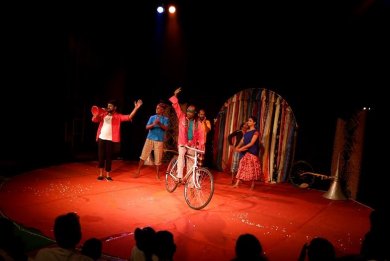
Charithrapusthakathilekkoredu
This year, the Monsoon Festival was further expanded to include more art forms, including music and theatre. The Monsoon Dance Music Theatre Festival (June 28 – July 2) inaugurated by the renowned Kutiyattam and performing arts scholar G. Venu, opened with a Malayalam play, ‘Charithrapusthakathilekkoredu.’ Drawing upon a Malayalam short story, ‘Upanyasam,’ that was written by the late Malayalam author T.V. Kochubava that dealt with the collapse of the street theatre culture that was in vogue in Kerala till the 80s, the play is designed and directed by Jose Koshy, the well-known light designer and presented by Invisible Lighting Solutions, Thrissur, with the script composed by James Elia. Made up of a cast of brilliant actors including Thushara, James Elia, Jose P. Raphael, Mallu P. Sekhar, Sudhi Vattappinni, Prathapan, Ramkumar, Vinod Gandhi and Nikhil Das, ‘Charithrapusthakathilekkoredu,’ was a good entertainer, engaging the audience with piquant humour and maudlin emotions, while delineating the popularity enjoyed by the street circus troupes and cycle yajnam artistes and their later disintegration before the changing times. The second day was devoted to music, with the Mumbai-based singer Anitha Shaiq, presenting a lilting recital of Sufi songs, gazals and qawwali. Starting with the popular Meera bhajan, “Mhara re Giridhar Gopal…” she went on to the Sufi kalams and naats. Then she rendered the popular gazal, “Aa jaane ki zid na karo…” Moving on to qawwali, she came out with Nusrat Fateh Ali Khan’s “Akhiyan.” More gazals followed with Mehdi Hassan’s “Pyar bhare do sharmile…,” the 14th century Sufi mystic Amir Khusro’s “Chaap Tilak Sab Cheeni…,” Sufi songs by Baba Bulleh Shah and Hazarat Sultan Bahoo. She also added her own compositions, including “Tere ishq nachaya…” The soulful concert throughout which Anitha engaged her audience with lively interjections wound up with the popular “Dama dam mast qalandar.” 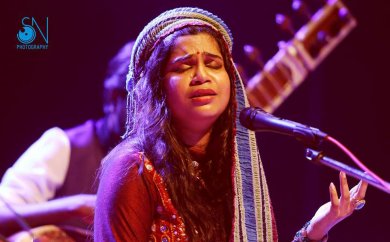 Anitha Shaiq 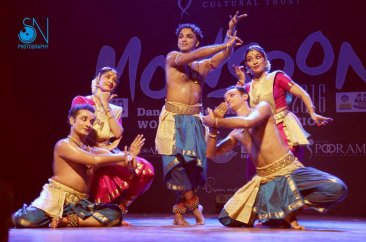 Hari Padman and team The third day was devoted to Bharatanatyam, presented by Hari Padman and team from Kalakshetra, Chennai. An alumnus of Kalakshetra who has been teaching there since 2003, Hari Padman started his recital with a composition based on the popular kirtana, “Gopalaka pahimam anisham.” The second item was the famed Swati Tirunal kriti, “Bhavayami Raghuramam” in Ragamalika, followed by a thillana in Sindu Bhairavi and adi talam, composed by Lalgudi Jayaraman. The team included Vidya Nair, Veeraja Shyam, Sanjith Lal, Saikrishnan and Sreedevi Jayakrishnan. Accompaniment was provided by K.P. Nandini (vocal), K.P. Rakesh (nattuvangam), Sivaprasad (mridangam), Ananthanarayanan (veena) and Sujith (flute). Light design was by Venkatesh. Next day was the Odissi recital by Aruna Mohanty, senior disciple of Guru Gangadhar Pradhan. Aruna Mohanty and her team presented five compositions, all choreographed by her except for the last one. Beginning with a traditional evocation of Lord Jagannath, “Jagadananda kandaya…” the recital moved on to the first item ‘Panchabhuta’ evoking the five elements – Prithvi, Jala, Theja, Marutha and Akasha, in flowing movements by male and female dancers. Music was by the renowned Odissi vocalist and composer, Guru Ramhari Das. The second one ‘Samsara’ explored the soul’s journey through the cycles of birth and death and how life is as short and transient like a droplet of water on the petal of a lotus. The composition, drawing upon Adi Sankara’s ‘Bhaja Govindam,’ had lyrics by Kedar Mishra, with Pandit Nithyananda Mishra interpreting the original Sanskrit text. Music was set by Guru Bijaya Kumar Jena with rhythm by Guru Bijaya Kumar Barik. The next one was a Pallavi, an item of pure dance, in Khamaj raga and ek taal. ‘Varasavisara’ was the exuberant welcoming of the eagerly awaited rains, after the unbearable heat of summer. The rhythm composition of the item was by Guru Dhaneswar Swain, with music composed by Guru Ramhari Das. The last item ‘Rasa’ elaborating the navarasas drawing from Ramayana was originally composed as a solo by Guru Gangadhar Pradhan with music by Gopal Chandra Panda and rhythm by Guru Banamali Moharana. Aruna Mohanty, for her group composition, chose Guru Bijaya Kumar Jena for the recomposing of the music and Dhaneswar Swain and Bijaya Kumar Barik for rhythm. Dancers included Sridutta Bhol, Janhabi Behera, Sreepunya Mohanty, Biswajit Das and Bijan Palal. Light design was by Jayadev Das. 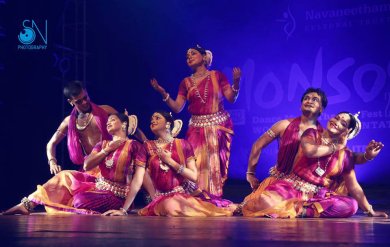 Aruna Mohanty and team 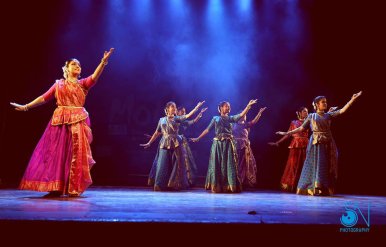 Parwati Dutta and team The festival concluded with a scintillating Kathak recital by Parwati Dutta and team, from Mahagami Gurukul in Aurangabad. Beginning with ‘Om Namah Sivaaya,’ an invocation to the 12 Jyothirlingams, she based the second part of the invocation of Siva, on the adaptation of the original composition of raga Devgiri Bilawal, composed by the legendary singer Gopal Nayak at the Devigiri (Daulatabad) Fort near Aurangabad, in the 14th century. The second item was Taal Roop, delineating Jhaptaal, the time cycle of 10 beats. It had music and lyrics composed by maestro Pandit Birju Maharaj. ‘Shiv Vasanth’ was based on a Tulsidas poem, narrating the transformation of the entire universe when Siva, the cosmic dancer, was struck by the arrow of Kamadeva. Set in the line of the ancient genre of Dhrupad, the piece had intrinsic rhythmic patterns woven through crisp footwork. For the solo abhinaya, Parwati Dutta chose the famed Swati Tirunal kriti, “Chaliye kunjanamo…” the beloved evoking her lover to visit the beautiful garden and to listen to the cuckoo. Celebrating the theme of monsoon, the next item was a classical Dhrupad composed by the legendary 15th century musician Tansen, celebrating the rainy season, and moving on to describe the Govardhan Leela, when Krishna heaved up the mountain to offer shelter to the people from the incessant rains. The next one was an emotive thumri, again celebrating the rains. The last one was ‘Nirjharineem,’ celebrating water, a dance tribute to the waterfall at the Ellora Caves near Aurangabad, called Sita ke Nahani. The item was based on Pandit Ravi Shankar’s composition of raga Tilak Shyam. Her dancers included Sheetal Bhamre, Kannagi Gosvi, Shreeya Dikshit, Anamika Sarkar, Snehal Katare, Rasika Talekar and Deepa. Light design was by Jose Koshy. Renu Ramanath is an independent journalist and columnist from Kerala specialising in performing and visual arts, architecture and developmental issues. Former Staff Reporter of The Hindu in Kochi bureau, she has been writing on art and culture in both English and Malayalam since 1992, contributing to print and online journals. |